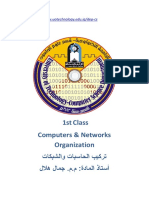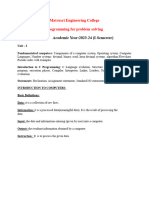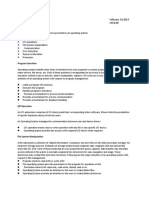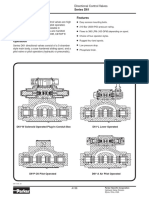0 ratings0% found this document useful (0 votes)
60 viewsBasIc Structure of Computer
Modern computers can be categorized as embedded, personal, servers/enterprise, or supercomputers/grid computers. The basic structure of computers includes input, memory, arithmetic and logic, output, and control units. Information is received as input, stored in memory, processed using arithmetic and logic functions, and output. The control unit coordinates all other units. Computation is governed by instructions that load data, perform operations, and store results.
Uploaded by
Jayvee ColiaoCopyright
© © All Rights Reserved
We take content rights seriously. If you suspect this is your content, claim it here.
Available Formats
Download as PPTX, PDF, TXT or read online on Scribd
0 ratings0% found this document useful (0 votes)
60 viewsBasIc Structure of Computer
Modern computers can be categorized as embedded, personal, servers/enterprise, or supercomputers/grid computers. The basic structure of computers includes input, memory, arithmetic and logic, output, and control units. Information is received as input, stored in memory, processed using arithmetic and logic functions, and output. The control unit coordinates all other units. Computation is governed by instructions that load data, perform operations, and store results.
Uploaded by
Jayvee ColiaoCopyright
© © All Rights Reserved
We take content rights seriously. If you suspect this is your content, claim it here.
Available Formats
Download as PPTX, PDF, TXT or read online on Scribd
You are on page 1/ 19
Basic Structure of
Computers
Prepared by: Dennis J. Tabucol
Computer Types:
Modern computers can be
divided roughly into four
general categories:
1. Embedded Computers
Used for a specific
purposed rather than for
general processing tasks.
Prepared by: Dennis J. Tabucol
Computer Types:
2. Personal Computers
Used for dedicated
individual use such as
general computation,
document preparation,
computer-aided design,
audio-visual
entertainment,
interpersonal
communication, and
Internet browsing.
Prepared by: Dennis J. Tabucol
Computer Types:
3. Servers and Enterprise
Systems
Large computers shared
by a potentially large
number of users who
access them from some
form of personal
computer over a public or
private network.
Prepared by: Dennis J. Tabucol
Computer Types:
4. Supercomputers and
Grid Computers
Offers the highest
performance and are the
most expensive and
physically the largest
category of computers.
Prepared by: Dennis J. Tabucol
What is Cloud Computing?
Where the personal
computer users access
widely distributed
computing and storage
server resources for
individual, independent,
computing needs through
the Internet.
Prepared by: Dennis J. Tabucol
Function Units:
Five Parts:
1. Input
2. Memory
3. Arithmetic and Logic
4. Output
5. Control Units
Prepared by: Dennis J. Tabucol
Function Units:
1. Input Unit
Accepts coded information from
human operation.
2. Memory Unit
Is the location where the information
received is stored.
3. Arithmetic and Logic
The processing steps are specified by
a program that is also stored in the
memory.
4. Output Unit
Where the result are sent back to the
outside world.
5. Control Unit
Coordinates all actions.
Prepared by: Dennis J. Tabucol
Function Units:
Information Categories:
Instructions Data
Machine Instruction Numbers and
Govern the transfer of characters that are used
information within a as operands by
computer as well as instructions
between the computer
and its I/O devices
Specify the arithmetic
and logic operations to
be performed
Prepared by: Dennis J. Tabucol
Function Units:
Input Unit
Accepts coded
information
Most common input
device is the keyboard,
touchpad, mouse,
joystick, microphones
etc.
Prepared by: Dennis J. Tabucol
Function Units:
Memory Unit
Primary/Main Memory
Fast memory that
operates at electronic
speed
Consists of a large
numbers of
semiconductor storage
cells representing one
bit of information
Read or written in a
fixed size called words
Address – provides
easy access to any
word in a memory,
provides location of a
word
Prepared by: Dennis J. Tabucol
Function Units:
Memory Unit
RAM
Any location cam be
accessed in a short
and fixed amount of
time
Memory access time
Required to access
one word
Ranges from
nanoseconds to
about 100
nanoseconds
Prepared by: Dennis J. Tabucol
Function Units:
Cache Memory
Smaller and faster RAM
unit
Holds sections of
program that are
currently being executed
At the program
execution, cache is
empty
During execution,
instruction are fetched
and placed in the cache
Prepared by: Dennis J. Tabucol
Function Units:
Secondary Storage
Primary storage is
expensive and does not
retain information when
power is turned OFF.
Less expensive and used
for less frequently
accessed information
Longer access times
E.g magnetic disk, DVD,
CD, and flash memory
device
Prepared by: Dennis J. Tabucol
Function Units:
Arithmetic and Logic Unit
(ALU)
Performs addition,
subtraction,
multiplication and
division or comparison
of numbers
Operands are brought
to the processor
Stored in high-speed
storage elements
known as registers
Prepared by: Dennis J. Tabucol
Function Units:
Output Units
Counterpart of the
input unit
Send process results to
the outside world
Prepared by: Dennis J. Tabucol
Function Units:
Control Units
Coordinates the
operation of the other
units
Is the nerve center
that sends control
signals to the other
units and senses their
states
Generates timing
signals that govern the
transfers
Prepared by: Dennis J. Tabucol
Basic Operation Concept:
Activity is governed by instructions
Load R2 (LOC)
• Reads the contents of a memory location (LOC) and
loads them to the processor register (R2)
• LOC data are preserved and R2 data are overwritten
Add R4, R2, R3
• R4= R2 + R3
• R4 data are overwritten with the addition result
Store R4, LOC
• LOC data are overwritten
Prepared by: Dennis J. Tabucol
Basic Operation Concept:
Processor Registers
• Instruction Register
- Holds the current instruction that is executed
• Program Counter
- Contains the memory address of the next instruction to
be fetched and executed
• General Purpose Registers
- Can hold operands for processing and other variety of
functions
Prepared by: Dennis J. Tabucol
You might also like
- BA_Notes_Chapter 1. Computer FundamentalsNo ratings yetBA_Notes_Chapter 1. Computer Fundamentals53 pages
- 6th Edition - Chapter 1 - Basic Structure of Computers-26!02!2021100% (1)6th Edition - Chapter 1 - Basic Structure of Computers-26!02!202158 pages
- Reserved: Basic Structure of Computers and Instruction SetNo ratings yetReserved: Basic Structure of Computers and Instruction Set20 pages
- MCA Computer Organization Architecture 01-MergedNo ratings yetMCA Computer Organization Architecture 01-Merged212 pages
- What Is A Computer?: 1. With A Neat Schematic Block Diagram of A Digital Computer Describe Its Functional UnitsNo ratings yetWhat Is A Computer?: 1. With A Neat Schematic Block Diagram of A Digital Computer Describe Its Functional Units38 pages
- What Is Computer and What Are Its Types?No ratings yetWhat Is Computer and What Are Its Types?5 pages
- Computer Organization and Architecture (18EC35) - Basic Structure of Computers67% (3)Computer Organization and Architecture (18EC35) - Basic Structure of Computers79 pages
- 1st Class Computers & Networks Organization تاكبشلاو تابساحلا بيكرت أ ذاتس داملا ة: .م م - للاه لامجNo ratings yet1st Class Computers & Networks Organization تاكبشلاو تابساحلا بيكرت أ ذاتس داملا ة: .م م - للاه لامج45 pages
- Computer Fundamental, Organization and ArchitectureNo ratings yetComputer Fundamental, Organization and Architecture19 pages
- Digital Logic Design and Computer Organization100% (2)Digital Logic Design and Computer Organization227 pages
- MODULE-1 (A) - Basic-Structure-of-ComputersNo ratings yetMODULE-1 (A) - Basic-Structure-of-Computers79 pages
- Computer Organization: Computer Architecture: It Refers ToNo ratings yetComputer Organization: Computer Architecture: It Refers To22 pages
- Group 1: Chapter Two 2 Computer OrganizationNo ratings yetGroup 1: Chapter Two 2 Computer Organization12 pages
- Unit 1 - Basic Structure of Computers - Functional UnitsNo ratings yetUnit 1 - Basic Structure of Computers - Functional Units3 pages
- UNIT-1: Computer Operation and Number SystemNo ratings yetUNIT-1: Computer Operation and Number System38 pages
- Computer Architecture and Organization (CAO) : Visvesvaraya National Institute of TechnologyNo ratings yetComputer Architecture and Organization (CAO) : Visvesvaraya National Institute of Technology50 pages
- Jayvee Mandal Coliao: Electrical and Junior PLC Programmer InternNo ratings yetJayvee Mandal Coliao: Electrical and Junior PLC Programmer Intern2 pages
- ACTIVITY NO. / TITLE: Activity 1 - Engineering Ethics INSTRUCTION: Identify and Discuss of What Action Will You Do in Given Problems Listed100% (1)ACTIVITY NO. / TITLE: Activity 1 - Engineering Ethics INSTRUCTION: Identify and Discuss of What Action Will You Do in Given Problems Listed4 pages
- Real Mode Memory Addressing: Arceño, Reggie Chica, Samira Coliao, Jayvee Manlolo, Jenny Tolentino, AubreyNo ratings yetReal Mode Memory Addressing: Arceño, Reggie Chica, Samira Coliao, Jayvee Manlolo, Jenny Tolentino, Aubrey10 pages
- Cpen 100 - Computer Networks Bachelor of Science in Computer EngineeringNo ratings yetCpen 100 - Computer Networks Bachelor of Science in Computer Engineering4 pages
- Jayvee M. Coliao February 06, 2019 Bscpe-4 1501-00126 Cpen 80No ratings yetJayvee M. Coliao February 06, 2019 Bscpe-4 1501-00126 Cpen 803 pages
- Jayvee M.Coliao February 10,2019 Bscpe-4 Cpen 85 1501-00126: Program ExecutionNo ratings yetJayvee M.Coliao February 10,2019 Bscpe-4 Cpen 85 1501-00126: Program Execution2 pages
- 2VAA002157 - en S Control IEMMU21 IEMMU22 Module Mounting UnitNo ratings yet2VAA002157 - en S Control IEMMU21 IEMMU22 Module Mounting Unit41 pages
- K. Lal Kishore - Electronic Measurements & Instrumentation-Pearson Education (2012) PDF80% (10)K. Lal Kishore - Electronic Measurements & Instrumentation-Pearson Education (2012) PDF449 pages
- Ee 419 Aed Spring 2024 Sessional Test-3 - Solution Set100% (1)Ee 419 Aed Spring 2024 Sessional Test-3 - Solution Set1 page
- ARA Series: Advanced Residential AmplifierNo ratings yetARA Series: Advanced Residential Amplifier2 pages
- IRB6600 6650 Typea M2000 M2000A M2004 Product Manual 3HAC020938-001 Rev-ENo ratings yetIRB6600 6650 Typea M2000 M2000A M2004 Product Manual 3HAC020938-001 Rev-E471 pages
- Taiwan Hardware SHOWROOMS - Fastener Manufacturer Directory Self Drilling ScrewNo ratings yetTaiwan Hardware SHOWROOMS - Fastener Manufacturer Directory Self Drilling Screw6 pages
- Valuation Report - by Country of Origin / Commodity: HS Code: 85044090 Other Static ConvertersNo ratings yetValuation Report - by Country of Origin / Commodity: HS Code: 85044090 Other Static Converters76 pages
- Making A Better K1-K3 GSXR OBD Adaptor CableNo ratings yetMaking A Better K1-K3 GSXR OBD Adaptor Cable8 pages
- ChargeUp Europe 2023 State of The IndustryNo ratings yetChargeUp Europe 2023 State of The Industry23 pages
- Cockcroft-Walton Voltage-Multiplier Circuit Generator0% (1)Cockcroft-Walton Voltage-Multiplier Circuit Generator3 pages









































































































